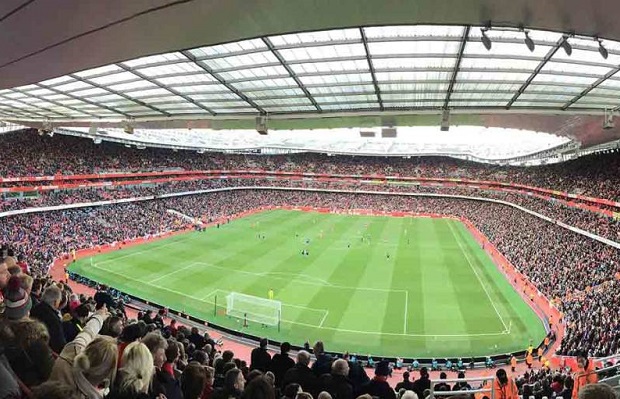- Arsenal showing ‘great interest’ in Aleksandar Stankovic
- Arsenal ‘crazy’ about signing Milan’s Davide Bartesaghi
- Arsenal eye move to sign Juventus star Kenan Yildiz
- Arsenal track Atalanta’s teenager Honest Ahanor
- Arsenal interested in Marseille’s teenager Darryl Bakola
- Arsenal make contact to sign Real Madrid’s Rodrygo Goes
- Arsenal to make ‘serious’ move to sign Ousmane Dembele
- Predicted Arsenal line-up vs Crystal Palace
- Arsenal track Atalanta defender Marco Palestra
- Arsenal step up watch on Milan teen Bartesaghi
Arsenal’s Semi-Final Tifo Misfire: A Symbol of English Football’s Ultra Disconnect
- Tweet
-
- Pin It
A Night to Remember – Or Forget?
Arsenal’s return to the Champions League semi-finals for the first time since 2009 should have been a night of grandeur. The Emirates buzzed with anticipation, hearts pounding in unison as Mikel Arteta’s men lined up against PSG in a clash decades in the making. Yet when the spotlight turned to the much-anticipated pre-match tifo, a sigh of disappointment swept across social media.
The display? A modest red flag draped with the club’s signature cannon emblem and a smaller, forgettable banner reading “Make it happen.” For many, it felt more like a routine Europa League group-stage send-off than the electric crescendo of a Champions League semi-final. Critics were swift and unforgiving – not least among them was Wayne Rooney, who bluntly remarked that the energy at the Emirates paled in comparison to the Real Madrid clash just weeks prior.
A Fanbase Let Down
This wasn’t just a case of aesthetic dissatisfaction – it struck at the heart of a long-standing cultural issue in English football. Arsenal fans, led by the energetic Ashburton Army, had been brimming with ideas. They had even managed to raise funds for a large-scale, choreographed display worthy of the occasion. But their vision never materialized. The club, citing logistical concerns and timing conflicts, opted for an internal approach – ultimately delivering what many called one of the most uninspired tifos ever witnessed at a top-level European tie.
Social media erupted with backlash. From Reddit threads to Twitter timelines, fans voiced frustration at the missed opportunity. “All that build-up, and we get a red sheet?” one fan posted, summing up the mood in North London. The sentiment wasn’t just about this one night; it was a boiling point, a moment that exposed a deeper disconnect between club hierarchy and grassroots fan passion.
Why England Can’t Match Europe
Across the continent, tifos are more than decoration – they’re ritual. They capture emotion, fuel players, and intimidate opponents. From Borussia Dortmund’s towering murals to Napoli’s historic tributes, European clubs regularly showcase a synergy between ultras and club administration. In contrast, many English clubs treat tifos as PR-managed assets, devoid of raw fan expression.
Experts at Boomerang Bet observed that the Emirates’ lifeless display is part of a broader pattern. “English clubs lack the integrated fan culture seen elsewhere,” one noted. “There’s hesitation – maybe even fear — in giving supporters creative control.”
Indeed, the roots of this divergence lie in culture. English football fandom has long leaned on vocal wit – chants, banter, pub debates. The visual spectacle, however, has been less prioritized. Without a deeply entrenched ultra movement, like those in Italy or Germany, English supporters rarely take full ownership of the stadium experience.
The Missed Opportunities
It’s not that English clubs can’t produce memorable tifos – it’s that they often choose not to. Aston Villa’s fanbase earned praise for a breathtaking tifo against Legia Warsaw earlier this season, and Crystal Palace’s Holmesdale Fanatics have long served as a domestic benchmark. These moments prove the potential is there.
But potential isn’t enough. It requires trust – and timing. In Arsenal’s case, fans had both the passion and the plan. The club’s decision to override them sent a discouraging message: “We appreciate your effort, but we’ll handle it.” It was sterile, safe – and entirely forgettable.
Cultural Blind Spots and Corporate Influence
Much of this conservatism comes down to risk management. Clubs worry that giving fans creative freedom could backfire. What if a message offends? What if the execution flops? This leads to sanitized, committee-approved visuals that lack soul.
Moreover, the commercialized nature of the Premier League feeds into the issue. Every display becomes part of the brand, every banner a potential Instagram post. The spontaneous, the rebellious – the authentic — often gets left behind.
But football is nothing without its heartbeat: the fans. And when that heartbeat is muffled under layers of red tape and marketing lingo, it shows.
What Needs to Change?
First, clubs must learn to collaborate, not dictate. Allowing supporter groups early involvement in planning stages can yield more resonant results. It’s not about handing over the keys – it’s about sharing the drive.
Second, there’s value in decentralization. Let tifos be grassroots expressions, not boardroom projects. When fans own the narrative, the atmosphere shifts. Players feel it. So do opponents.
Lastly, it’s time English football stopped viewing ultras as a threat and started seeing them as partners. Yes, guidelines are necessary – but they shouldn’t suffocate creativity. They should channel it.
The Bigger Picture
This isn’t just an Arsenal problem. It’s a Premier League problem. And in a global footballing landscape where atmospheres matter – where fans are often judged by their color, volume, and spectacle – England’s top flight risks becoming visually sterile.
Ironically, it’s the smaller clubs, with tighter communities and less red tape, who lead the way. If the giants want to create nights to remember, they must be willing to step back and let the people who live for this game lead the charge.
Looking Ahead
Arsenal may yet go on to lift the Champions League trophy this season. But even if they do, the flat tifo on that semi-final night will linger in fans’ memories – not as a badge of pride, but as a symbol of what could’ve been.
The Ashburton Army’s passion didn’t go unnoticed. Nor did the fans’ collective voice. And maybe, just maybe, this misfire will spark a new chapter. One where clubs listen more, trust deeper, and dare to create something unforgettable – together.
Latest News
-
Arsenal showing ‘great interest’ in Aleksandar Stankovic
Arsenal are reportedly showing a ‘great interest’ in signing Club...
- Posted December 25, 2025
- 0
-
Arsenal ‘crazy’ about signing Milan’s Davide Bartesaghi
Arsenal are reportedly ‘crazy’ about signing AC Milan star Davide...
- Posted December 25, 2025
- 0
-
Arsenal eye move to sign Juventus star Kenan Yildiz
Arsenal are reportedly planning to make a move to sign...
- Posted December 25, 2025
- 0
-
Arsenal track Atalanta’s teenager Honest Ahanor
Arsenal are keeping a close eye on Atalanta defender Honest...
- Posted December 24, 2025
- 0
-
Arsenal interested in Marseille’s teenager Darryl Bakola
Arsenal are keeping close watch on Marseille youngster Darryl Bakola,...
- Posted December 24, 2025
- 0
-
Arsenal make contact to sign Real Madrid’s Rodrygo Goes
Arsenal have reportedly made contact over a deal to sign...
- Posted December 24, 2025
- 0
-
Arsenal to make ‘serious’ move to sign Ousmane Dembele
Arsenal are reportedly planning to make a ‘serious’ move to...
- Posted December 24, 2025
- 0

Latest News
-
Arsenal showing ‘great interest’ in Aleksandar Stankovic
Arsenal are reportedly showing a ‘great interest’ in signing...
- December 25, 2025
- 0
-
Arsenal ‘crazy’ about signing Milan’s Davide Bartesaghi
Arsenal are reportedly ‘crazy’ about signing AC Milan star...
- December 25, 2025
- 0
-
Arsenal eye move to sign Juventus star Kenan Yildiz
Arsenal are reportedly planning to make a move to...
- December 25, 2025
- 0
Football Betting
- Best non gamstop casinos UK
- Casinos not on gamstop
- Casinos not on gamstop
- Gambling sites not on gamstop
- Gambling sites not on gamstop
- Online casino sites
- Casinos not on gamstop
- Betting sites not on GamStop
- Casino sites not on gamstop
- Casino sites not on gamstop
- Non gamstop bookmakers
- Online bookmakers
- European betting sites
- Not on gamstop




